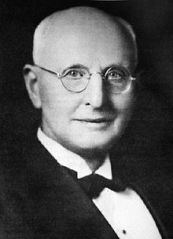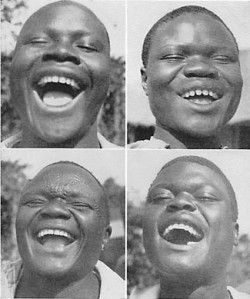In November, my boyfriend and I attended the annual “Wise Traditions” conference, held by the Weston A. Price Foundation (“WAPF”) in Santa Clara, CA. We went to talks ranging from informative to entertaining to kooky, tucked into some gluten-free cheesecake, and adopted a slimy kombucha SCOBY.
Weston A. Price (or “How to Get a Foundation Named After You”)
Weston A. Price was a dentist in the early 1900s who spent decades traveling to remote parts of the world in a quest to understand the causes of tooth decay. In the process, he discovered that primitive populations that continued to eat traditional foods (of all sorts) had better teeth and were in better health than those that had adopted the standard Western diet (white sugar, white flour). People on traditional diets didn’t have cavities and generally didn’t suffer diseases like diabetes, cancer, or heart disease. He set down his findings in Nutrition and Physical Degeneration (1939), published long before peer-reviewed research existed. The book contains photographs of multiple generations within the same tribe, showing the changes in dental health and even facial structure from one generation to the next. The tribes he followed all had different traditional diets; people in a remote Swiss village ate mainly cheese and rye bread, for instance, while the Masaai survived on raw meat and milk — but health universally deteriorated when these people adopted the standard Western diet.
Controversially, Price believed that meat was an essential part of a healthy diet, as he was unable to find a healthy tribe that subsisted on a purely vegetarian diet. He also believed that the Western diet had the the ability to override genetics and alter a child’s facial structure. He took countless photographs of people on traditional diets with broad nostrils, wide jaws, and perfectly set teeth, contrasting them with people on the standard Western diet, which he claimed resulted in pinched nostrils, narrow jaws, and crowded teeth.
A half-century later, the Weston A. Price Foundation was established with the goal of teaching others about Price’s research. It promotes “nutrient-dense” foods, including animal fats and organs, and advocates against the use of white flour, sugar, and vegetable oil. It also comes off as being cultish and unwilling to accept conventional scientific beliefs, particularly with regard to saturated fat.
Wise Traditions 2012
In some ways, the conference was like a large evangelical Christian gathering, with Weston A. Price’s face prominently displayed as if he were a religion’s founding father. Many speakers presented on topics that were a logical extension of Price’s findings, while others simply came off as quacks peddling fake remedies; similarly, a large evangelical gathering might include both Christians well-versed in Bible tradition and self-styled “modern day prophets.” One man claimed that he could heal the body by keeping cells at the optimal voltage, saying in his abstract that “cells must have enough voltage to work and that chronic disease, impacted by acid/alkaline states, [is] associated with loss of voltage.” Another discussed the magical restorative effects of magnetism, claiming that a full-body application of a magnetic field could “dramatically [reduce] the body’s free radicals, [speed] healing of bones, and increase oxygen in the blood.”
The presence of some obviously kooky presenters colored my opinion of the other health and nutrition speakers, most of whom did not have formal medical or scientific qualifications. I enjoyed the first talk of the day, which was a discussion of the underlying characteristics of traditional diets; the standard Western diet certainly seems unhealthy in comparison with traditional diets that focus on natural and unprocessed foods. The next speaker, blogger Chris Masterjohn, discussed the role of key amino acids and vitamins in promoting mental health. Though he seemed smart and well-qualified (he has a PhD in nutrition science), his talk went over my head. Worst of all was a long, dull talk on Alzheimer’s, which the speaker attributed to a “breakdown in the glutathione cycle.” His presentation was utterly impenetrable, full of chemical diagrams and lengthy names of organic compounds. He seemed to be intentionally using difficult language to make himself more believable and disguise a flawed premise. Bored, I looked up the speaker on my phone and discovered that he had never formally studied organic chemistry and claimed that he could cure both Alzheimer’s and herpes through nutrition.
Most health speakers in the conference, though, fell in a gray area between obviously kooky and mostly believable. Our last nutrition talk that day was with Chris Kresser, a licensed acupuncturist and practitioner of integrative medicine, who talked about the relationship between acne and bowel problems. He didn’t have a degree from the scientific/medical establishment, but had spent a lot of time thinking about nutrition and was able to offer case studies of patients from his own practice. While certain methods may have worked on some of his patients, they haven’t been broadly tested in randomized clinical trials and haven’t been scientifically proven to be effective.
The talks on organic farming proved more enjoyable than the talks on the “nutrition” track. Dairyman Mark McAfee gave an entertaining talk about his father, the dairyman and activist Rodger McAfee, and about the early days of Organic Pastures Dairy, California’s first raw milk dairy. Chris Kerston of Chaffin Family Orchards discussed reversing desertification through the use of grazing cattle. The technique relies on tightly packing cattle together and moving them over a grassland, a practice known as “bunching.” When cows are grazed like this, they remove dead material from grasslands, allowing light and rain to reach the new grass shoots. They also graze the pasture in a uniform way, instead of stripping the pasture of their favorite plants. Kerston also introduced us to the law of the second bite, asking,”Is it more destructive to graze 100 cattle on 1 acre for 1 day, or 1 cow on 1 acre for 100 days?” Counter-intuitively, he says, the former is less destructive than the latter. When a cow is given free rein of a pasture, it preferentially eats the leaves from its favorite plants. Unable to use photosynthesis for energy, plants use up the energy stored in their roots to regrow their leaves. When the cow eats the regrown leaves, the plants die, unable to use their roots for energy. When cows are freely grazed, some plants may never recover. In contrast, when they are kept in tightly packed and continuously rotated groups, the grass is evenly consumed and the pasture is uniformly fertilized.
There were hundreds of vendors at the conference, peddling everything from DIY kombucha and cheesemaking kits to sleeping pads with healing magnetic fields. Memorably, there was a booth from Paleotechnics, an group that teaches traditional primitive arts; it was full of foraged nuts and home-tanned deer hides. We managed to resist most of the booths, with the exception of a kombucha SCOBY, which has kept us well supplied with probiotic tea ever since.



Posted on December 26, 2012
0